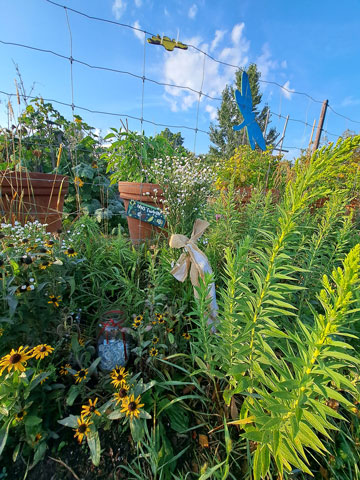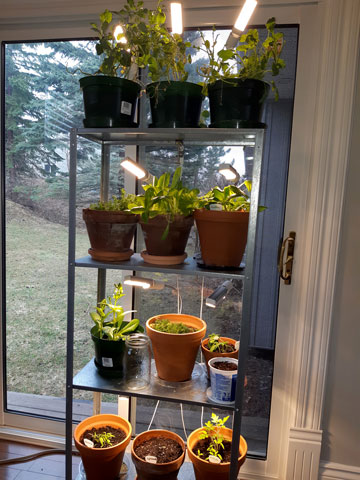2/1/2023
Planting the Seed for Future Growers
Anne-Marie Hardie

Food sustainability has become an essential part of education, with food scarcity in cities and an alarming trend of youth being disconnected from their food source. Organizations like EcoSource, a hands-on, not-for-profit organization, are actively working with schools and community members to promote sustainability education, waste reduction, urban agriculture and a connection to nature.
Inspired by the community garden projects throughout the city, Morning Star Middle School’s Art and Technology teacher Catherine Everett approached the school about starting one of their own. Morning Star Middle School is in the Malton neighborhood in Mississauga, Ontario, an urban city center near Pearson Airport.
Community gardens do much more than teach youth about growing—they foster a sense of community and citizenship. However, launching a community garden at a middle school requires a substantial amount of planning, resources (both financial and human) and commitment.
Pictured: The community garden at Morning Star Middle School in Mississauga, Ontario.
“The project required a team effort of teachers, parents, custodial staff and students for it to be successful,” said Rachel Graf, a sixth-grade homeroom teacher.
Once the project was approved, the educational team launched into the paperwork, including accessing permits, developing landscape plans to build raised garden beds and applying for several grants, including the Canadian Wildlife Federation (CWF), which donated pollinator plants to the initiative.
“The community garden project became part of the after-school club, The Green Team, which began with the garden and has now extended into a variety of environmental initiatives,” shared Rachel.
The initial plant donations were received at the school in the spring of 2020, during a school closure. However, a dedicated team of teachers came to the school, created the garden beds and ensured that the plants were in the ground and maintained until the students return. Although the pandemic presented a few hurdles, the school team and community were committed to the project and proceeded forward.
The students returned to in-person schooling that fall; however, since the program involved multiple grades and groups, planning sessions were all conducted online.
“We had almost a full year of meetings online because the pandemic prevented the students from mixing groups,” said Rachel.
The instruction involved a collaboration between several teachers, who invested their time to share their knowledge about plants and gardening. One way that Rachel helped increase engagement was through online demonstrations, using her shelf garden and backyard greenhouse to showcase planting projects that the students could begin at home. The students were shown a variety of recyclable containers that they could adapt into pots to grow their seeds and seedlings.
“Students used egg cartons, yogurt containers, really anything that they could find around their home to start their plants,” said Rachel.
The students were then taught how to maintain their plants at home, including how to set up the proper lighting and care that they needed. The students brought these seedlings to their school in the spring once the severe pandemic restrictions, including another closure in the winter, were lifted.
Education was at the root of the entire project, including extensive discussions about food sustainability and the role that community gardens could play in alleviating these societal strains. In addition, the project provided an opportunity for teachers in several areas of study, including science, social studies and geography, to provide an interactive, meaningful experience to their students.
 “The students had many discussions of what to do with the produce from the garden,” said Rachel. “Some students brought plants home, some of the produce was sold at the local farmers markets, and some went to the school cafeteria to offer snacks and small salads to the students.”
“The students had many discussions of what to do with the produce from the garden,” said Rachel. “Some students brought plants home, some of the produce was sold at the local farmers markets, and some went to the school cafeteria to offer snacks and small salads to the students.”
Pictured: Sixth-grade teacher Rachel Graf created a “demonstration shelf garden” in her home to use for online teaching during the pandemic.
The knowledge gained from the online meetings fostered teamwork, which was strengthened as the team moved to in-person, particularly for those individuals who volunteered to tend the garden in the summer. To maintain the garden throughout the summer, students, teachers and custodial staff worked together to create a schedule that would ensure that the plants would be well cared for.
“The students showed commitment to the project; it truly fostered good citizenship skills and volunteerism to tend the garden,” said Rachel. “It helped to show that students can work together with their community and give back.”
Now in the project’s second year, the school is continually looking for additional ways that the garden can be used for education and community engagement.
“The goal is to keep the community garden going and to continue using it as an outdoor learning center for classes—not only as an after-school project, but teachers can also use it to connect with their social studies and science projects,” said Rachel.
The Green Team initiative, the umbrella under which the community garden has fallen, is also continually developing as students and teachers expand into other areas to give back to the environment and the community. Strong teamwork has helped ensure that this project was a success and is vital to broadening the project’s scope in the future. GT
Anne-Marie Hardie is a freelance writer/speaker from Barrie, Ontario, and part of the third generation of the family-owned garden center/wholesale business Bradford Greenhouses in Barrie/Bradford, Ontario.